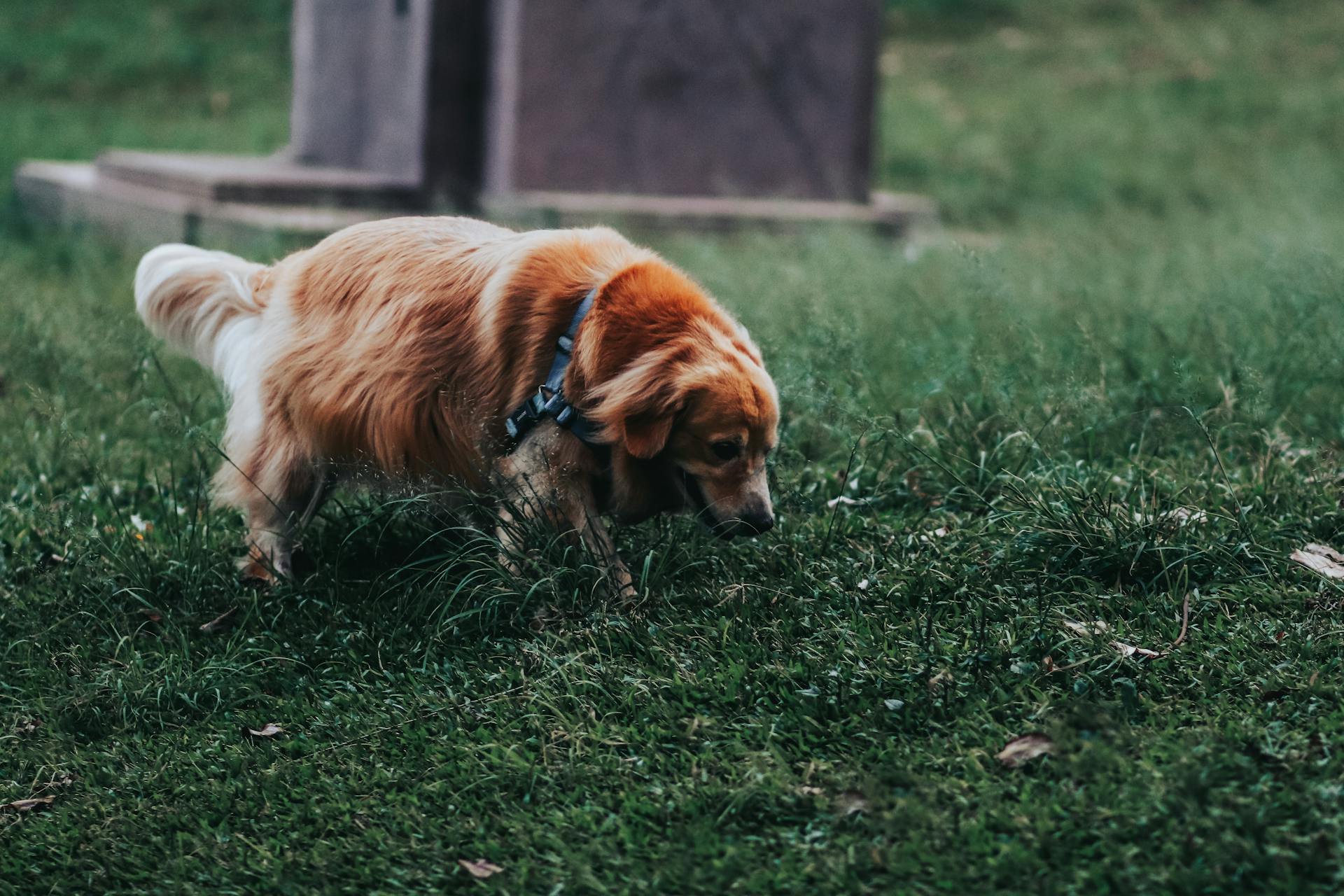
Herding dog behavior problems can be a challenge to manage, but understanding the underlying causes can help you address them effectively.
Herding dogs are bred to work in packs, so they often have a strong instinct to chase and gather. This can lead to problems like nipping at heels and overwhelming other pets in the household.
To fix herding dog behavior problems, it's essential to recognize the triggers that set off these behaviors. For example, if your herding dog is triggered by movement, you can try to desensitize them to it by gradually exposing them to more movement over time.
In some cases, herding dog behavior problems can be caused by boredom or lack of mental stimulation, which can lead to destructive behavior like digging and chewing.
Understanding Herding Dog Behavior
Herding dog behavior can be a challenge for owners, but understanding its root causes can help you address the issue effectively. Herding breeds, like Australian Shepherds, are born with a strong herding instinct that can lead to behaviors like nipping and chasing.
Australian Shepherds, in particular, are renowned for their intelligence, agility, and strong work ethic, which makes them prone to herding behaviors. Their herding instinct is a trait that originates from their history as working dogs on ranches and farms.
Herding breeds exhibit their herding instincts through various behaviors, including nipping at people's heels, circling, barking, and staring intently at their "flock." These behaviors are hardwired into their nature and can be triggered by movement, not an attempt to demand attention or misbehave.
Recognizing the signs of herding behavior is crucial to managing it. Herding breeds often give warning signs before they start herding, such as dropping their head, crouching, or staring at the target. By watching your dog for these signs, you can intervene before they start to move towards the person or object.
To redirect herding behaviors, you can use toys as distractions, engage in structured play sessions, and reward your dog when they choose to engage in appropriate activities instead of herding behaviors. This can help prevent unwanted behaviors and keep your dog engaged.
Here are some common manifestations of herding behavior in Australian Shepherds:
- Herding/Corralling: Your dog's primary instinct to gather, move, and protect has been cultivated through thousands of years of breeding.
- Sighting: An expression of herding, you may notice your dog stalking and scoping out unsuspecting individuals.
- Barking: Herding breeds can be very vocal, as barking is a tool for moving animals.
- Nipping: Certain herding breeds use small nips to motivate movement in other animals.
- Chase/Fetch: Since the majority of herding breeds are blessed with incredible focus and energy, they can become fixated on a game or task, such as fetch.
Addressing Problem Behaviors
Herding breeds like Australian Shepherds and Great Pyrenees can exhibit problem behaviors due to their strong herding instincts. These behaviors can be challenging to manage, but understanding the causes and taking proactive steps can help.
Herding behaviors can be triggered by movement, not attention-seeking, and may manifest as herding, corralling, sighting, barking, nipping, or chasing. Recognizing these behaviors can help owners redirect their dog's energy into appropriate outlets.
To address problem behaviors, it's essential to use positive reinforcement training, providing mental and physical stimulation, and engaging in structured playtime. This can help redirect herding behaviors into activities like retrieving or herding games.
By minimizing disruptions and creating a positive environment, owners can promote a harmonious household. This can be achieved by addressing herding behaviors proactively, reducing unwanted behaviors like excessive nipping, chasing, or barking.
Here are some common problem behaviors in herding breeds and tips to manage them:
Stopping Your Dog's Nipping Behavior
Stopping your dog's nipping behavior requires understanding that it's a natural expression of their herding instinct. Herding breeds like Australian Shepherds are born with this instinct, which can emerge as early as six months old.
The key to stopping nipping is to recognize the triggers and signs that lead to herding behavior. This can include people running, riding bikes, or other animals that get your dog going. Identifying these triggers will help you intervene before the behavior becomes a problem.
One effective way to manage herding behavior is to teach your dog the "leave it" or "no bite" commands. This can be done by providing appropriate chew toys to redirect their behavior. Consistency and patience are essential in teaching your dog these commands.
It's also essential to understand that nipping is not a sign of disobedience, but rather a natural expression of their herding instinct. Yelling or punishing your dog for nipping can make the behavior worse, as it may trigger their prey drive.
To redirect herding behaviors, use toys as distractions, initiate structured play sessions, and reward your dog for choosing appropriate activities instead of herding behaviors. This can help prevent unwanted behaviors and keep your dog engaged.
Here are some common signs that your dog is about to start herding behavior:
- Dropping their head
- Crouching
- Staring at the target
By recognizing these signs and intervening early, you can help your dog develop self-control and reduce unwanted behaviors.
Pyrenees Behavior Problems
If you're experiencing behavior problems with your Great Pyrenees, you're not alone. Aggression toward strangers is a common issue, often stemming from their protective nature. Early socialization is key to mitigating this behavior, so introduce your Pyrenees to various people, environments, and situations during their puppyhood.
Positive reinforcement training can help them learn appropriate reactions to unfamiliar faces. For example, if your Pyrenees exhibits aggressive behavior towards a stranger, calmly saying "no" and withdrawing the attention can help them associate the stranger with a negative outcome.
Separation anxiety is another prevalent problem in Great Pyrenees, often resulting in destructive behavior, excessive barking, and attempts to escape. Gradual desensitization to being alone and creating a secure environment are crucial steps in tackling this anxiety.
To manage excessive barking, teach your Pyrenees the "quiet" command and provide mental and physical stimulation. Their guardian nature can lead to barking to alert their owners of potential threats, but with training, they can learn to differentiate between real threats and false alarms.
Digging is a natural behavior for many dogs, including Great Pyrenees. Providing a designated digging area in your yard and rewarding them for using it accordingly can help channel their digging instincts away from unwanted spots.
Here are some common behavior problems in Great Pyrenees and ways to manage them:
- Aggression toward strangers: Early socialization and positive reinforcement training
- Separation anxiety: Gradual desensitization and creating a secure environment
- Excessive barking: Teaching the "quiet" command and providing mental and physical stimulation
- Digging: Providing a designated digging area and rewarding good behavior
- Roaming tendencies: Keeping them on a leash or in a securely fenced area
- Stubbornness and independence: Consistent, positive reinforcement training
- Chasing and herding behavior: Redirecting their focus onto toys or other activities
- Table behavior issues: Teaching proper table manners and using commands like "leave it" to discourage food stealing
- Grooming challenges: Regular grooming to prevent matting and maintain fur health
Redirecting Behaviors into Appropriate Outlets
Herding dogs, like Australian Shepherds, are born with an innate herding instinct that can manifest in various behaviors, such as nipping at people's heels, chasing, and barking. If not channeled properly, these behaviors can lead to unwanted issues.
To redirect these behaviors, it's essential to understand the triggers and signs that indicate your dog is about to start herding behavior. Australian Shepherds, for instance, may exhibit herding behaviors in response to movement, such as people running or riding bikes nearby.
Once you've identified the triggers and signs, you can begin to intervene in a controlled environment. Put a leash on your dog with a long lead and have someone engage in the behavior that usually triggers a herding response. Watch your dog for signs that they're about to start herding behavior and give the "come" command to redirect their attention.
You might enjoy: Do German Shepherds Have Separation Anxiety
In order to have the training stick, commit to about 20 minutes per day until your dog is reliably able to focus on you and not give in to their herding instinct.
Here are some strategies to redirect herding behaviors into appropriate outlets:
- Use toys as distractions to divert your dog's attention.
- Engage in structured play sessions that focus on retrieving or herding games.
- Reward your dog when they choose to engage in appropriate activities instead of herding behaviors.
By redirecting your dog's herding behaviors into positive outlets, you can prevent unwanted behaviors and create a harmonious household.
Socialization and Training
Early socialization and training are crucial for Australian Shepherds, as they help your dog understand appropriate behaviors and boundaries. Start socializing your Aussie from a young age, exposing them to various environments, people, and other animals to build their confidence and adaptability.
To begin, begin socializing your Australian Shepherd from a young age. This will help them build confidence and adaptability in different situations. Consistent training is also essential, using positive reinforcement techniques to reward desirable behaviors and gently discourage unwanted ones.
Implement consistent and positive reinforcement training techniques, rewarding your Aussie for good behavior and gently discouraging bad behavior. This will help your dog manage their herding instincts effectively. To set clear boundaries, teach commands such as "leave it", "no bite", and "stay."
Here are some key socialization and training tips to keep in mind:
Preventing Unwanted Behaviors
Preventing unwanted behaviors in herding dogs requires understanding their instincts and taking proactive steps.
Herding breeds like Australian Shepherds and Great Pyrenees are born with a strong herding instinct that can manifest in various behaviors, including nipping, chasing, and barking.
To prevent these behaviors, it's essential to identify the triggers that set them off. For example, Australian Shepherds may start herding people or other animals when they see movement or hear sounds that mimic those of prey.
Once you've identified the triggers, you can begin to intervene before the behavior starts. For instance, if your dog tends to herd people, try to catch them before they start to move towards you by giving the "come" command.
Consistency and patience are key when training your herding dog. Set aside 20 minutes per day to work on redirecting their energy into positive outlets, such as structured playtime or herding games.
Here are some specific strategies to help you prevent unwanted behaviors in your herding dog:
By understanding your herding dog's instincts and taking proactive steps, you can prevent unwanted behaviors and create a harmonious household where everyone feels safe and happy.
Frequently Asked Questions
Are herding dogs aggressive?
Herding dogs are not inherently aggressive, but their natural instincts can make them wary of strangers, which may be misinterpreted as aggression. Understanding their herding behaviors is key to recognizing and addressing any potential issues.
Sources
- https://www.southtexasaussierescue.org/what-to-do-about-dog-biting-and-nipping-due-to-herding-instinct/
- https://medium.com/@theinfoanimals/great-pyrenees-behavior-problems-a-comprehensive-guide-bd5804545a4d
- https://aussiebase.com/herding-instinct/
- https://www.ellevetsciences.com/blog/why-does-my-dog-herd-me/
- https://dancingheartsdogacademy.com/a-fun-game-to-satisfy-your-herding-dogs-herding-instinct-when-you-dont-have-sheep-to-work/
Featured Images: pexels.com


